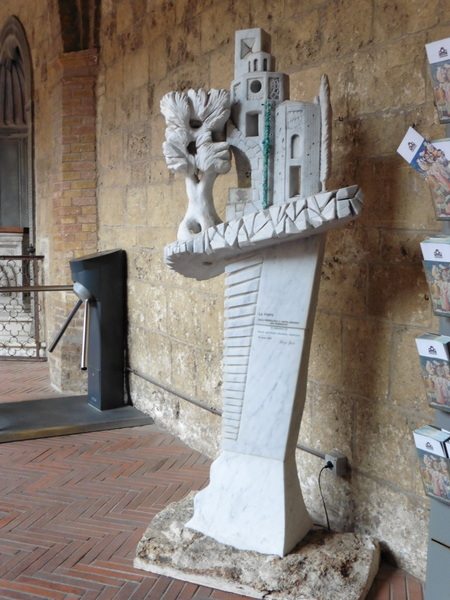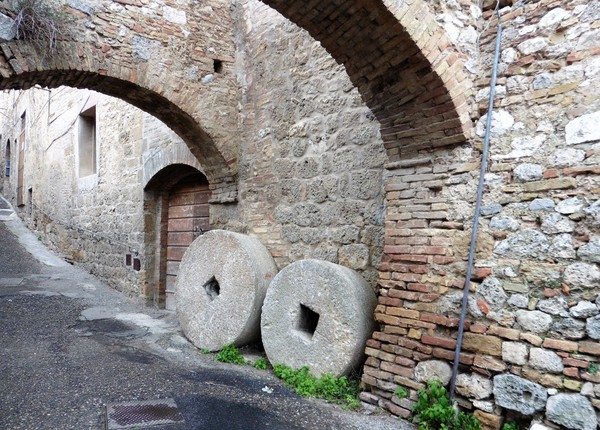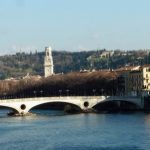The weather was raining, cold and windy this morning as we peered out the window. Michele was still excited enough to open all the windows just to take in the view.

There was no mistaking just how beautiful the views across Tuscany are. We’ve been able to book at an old farm La Piazetta which specialised in agritourism. The farm grows grapes and olives but has converted the farm buildings into accommodation. The old cream brick buildings with terracotta roofs really have a lot of character. Everything about the place is a little magical. From our window we could see nearby San Pietro surrounded by rows of olives trees and on the hills beyond rows of grapes.
As the weather forecast was for showers we headed for nearby San Gimignano, one of the fortified towns which are a feature in this part of Tuscany.
San Gimignano

San Gimignano dates back to at least the 1st century when a castle was built on the hill and the town gained the name of Silvia. Our old mate Bishop Geminianus (also known as the Saint of Modena after saving Modena from invading Huns by conjuring up fog) worked his magic at Silvia in 450 AD saving the castle from the invading Huns. In thanks for salvation the town was renamed in honour of the Bishop, and became known as Gimignano. The town steadily grew into a fortified town and became a stopping point for pilgrims on their way to Rome or the Vatican City along Via Francigena. Around the area saffron was grown for use as a dye or in food. It was also an area of quality wine production. With limited space for building in San Gimignano during the medieval period tower houses became the trend. Instead of building out families built upwards. It was also a social statement and during this time there were about 70 tower houses in the town. Of the original 70 tower houses, 14 of these are still standing. These days the tower houses can be seen from a long way from the town. It gives San Gimignano a special feeling.
San Gimignano is walled on three sides and access to the centre is restricted to inhabitants only with parking below the castle walls. However, we headed up inside the walls and found a park.

Inside the walled town Via San Matteo leads up from the gate of the same name to Piazza Duomo. On either side of the road tiny alleys and streets disappear between buildings. Piazza Duomo is overlooked by the San Gimignano Duomo, and various medieval buildings including the tourist bureau.
The Duomo is actually just a church and has never been anything else although it calls itself a duomo. It’s accessed by purchasing a ticket at the nearby Museum of Religious Art. The ticket gives access to both the museum and church.
Museum of Religious Art

The museum features various pieces of church art including paintings, stone fragments from various churches, silver objects, statues, vestments, medieval books and other articles. On the upper floor of the museum glass cabinets were filled with vestments and altar frontals. The stitching and patterns on the ancient cloth was just amazing.
San Gimignano Duomo

After a visit to the museum we headed to the church. San Gimignano Duomo or Basilica Of Santa Maria Assunta was consecrated in 1148. The interior of the church is covered in frescoes featuring stories from the new and old testament. The frescoes were painted by artists from the Sienese school during the 14th century. It’s quite amazing how well preserved the frescoes are despite their age.The Duomo is such a beautiful place to visit and just sit to enjoy the frescoes, sadly there were no photos allowed so we can;t share them with you….but I am sure you can find some via google.

Within the church is the Chapel of Santa Fina. It was decorated by three florentine artists Giuliano da Maiano, Benedetto da Maiano, and Domenico Ghirlandaio. The chapel was dedicated to a Santa Fina, a local girl who at the age of ten was afflicted by a serious illness which paralysed her. The next five years of her short life was spent lying on a wooden board. During this time both of her parents died and she was left penniless. She inspired others with her indomitable attitude. After her death she was deemed a saint and locals prayed to her for deliverance from the plague in 1479, and again in 1631. Since 1481 she has been venerated by locals. Her relics are paraded through the town on the anniversary of her death on March 12th and again on the first Sunday of August. It’s a form of blessing the town.
Around San Gimignano violets known locally as Santa Fina violets bloom in march around the anniversary of her death.
The house where she lived during her short life from 1238 until 1253 is a museum not far from Piazza Duomo.
Around the town are lots of churches and religious buildings. There are also a few museums including the Museum of Wine which was unfortunately closed.

San Gimignano is a lovely town to walk around and from different vantage points there are great views across the landscape. As the weather was quite windy the walls just funnelled the bitter breeze down the streets. It was definitely too cold to stay out in. We found a small inn to warm up in with a spot of lunch.
As the weather was starting to close in we headed back to the farm. Along the way we could see the clouds getting closer and closer. About two kilometres from the farm hail and snow started falling. Luckily it didn’t rain and we arrived home dry. Tomorrow the forecast is for sun so we’ll take a trip into Sienna.







One thought on “San Gimignano”